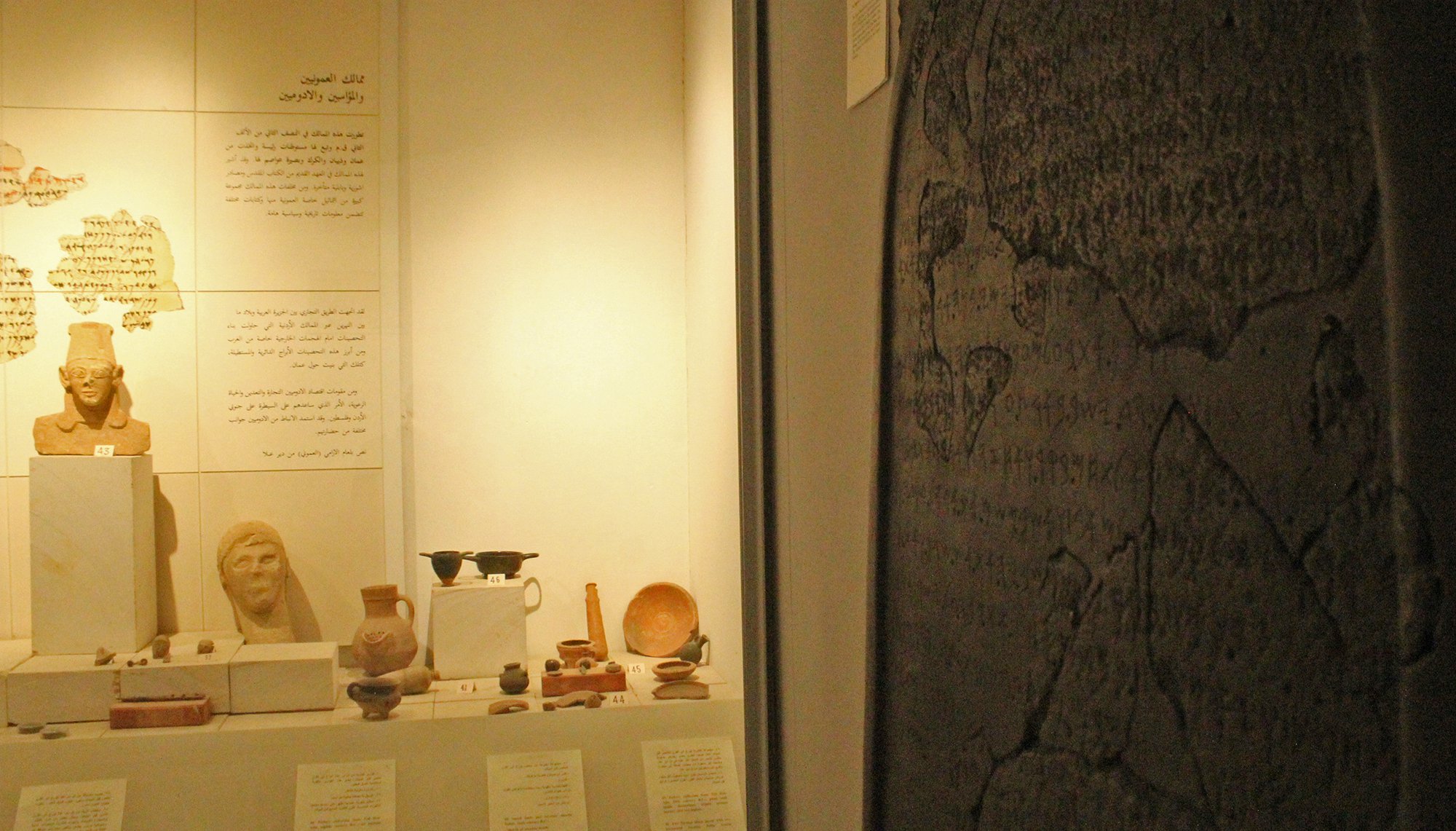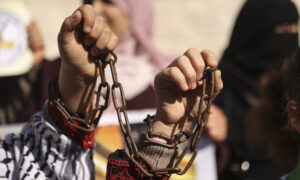A hundred and fifty years ago, an artifact was discovered in Madaba’s Thiban county. It is known as the Mesha stele or the Moabite stone. The written inscription on the artifact grabbed the attention of some European consulates, and their interest resulted in a diplomatic war to obtain it. The writing was considered, by some Torah researchers, to be the most important text written on Jews since the 9th century BCE. This artifact departed Jordan for the Louvre Museum, where it still remains , despite Jordanians’ years-long demands to return it. Will international law and accords permit its recovery?
A diplomatic competition to possess “Mesha” in the 19th century
During the 19th century, when archaeologists and amateurs were traversing the Levant looking for archaeological evidence that would affirm the historical accuracy of the Bible, a Prussian priest, Frederick Klein, was on a journey to Ajloun mountain and Al-Baqa’a in the fall of 1868.
According to British historian Christian Ginsburg, the priest’s expedition reached Thiban in Madaba where he was alerted by his friend and protector Sheikh Sitam Fandi Al-Fayiz, a chief of the Bani Sakhr tribe, that there was a stone with writing engraved 10 minutes from where they had camped.
Klein made a drawing of some of the written words, without understanding their significance, and traveled to Jerusalem. News of the inscription spread among consulates and archaeologists who inferred an idea of the stele’s content from the few words Klein had recorded. According to Ginsburg, the French, British, and Prussian consulates vied to obtain it, but the Prussian consul had preceded them in the negotiations.
The Prussian consul, Heinrich Baterman, sent a letter to Sheikh Sitam Fandi Al-Fayiz, asking for his help in obtaining the stone, but nothing came out of the attempt
Later, he sent an Arab teacher to negotiate with the locals about the stone. But at their meeting, the local Sheikh asked for a then astronomical sum of 1000 pounds.
Baterman writes: “I immediately wrote to Berlin on March 19, 1869: ‘Now, I cannot obtain the stone except with the intervention of the Turkish government.”
A new archaeological discovery appeared on the scene, which further delayed the already-glacial pace of the Prussian consulate’s efforts to obtain the stone.
This situation pushed the French consulate in Jerusalem, in the spring of 1869, to contact Klein to confirm the story of Prussian negotiations with the Ottoman government. Upon hearing of the process’s delay, the young French consul of Jerusalem, Charles Clermont Ganneau, leapt into action. He announced a reward of 375 pounds upon delivering the stone.
The Ottoman governor in Nablus learned of the prize, and, coveting it, sent for the mayor of Al-Salt to hand it over, angering the locals.
The locals set fire to the stone, then dumped cold water over it, shattering it, and distributed its shards among the local families. This occurred in November of 1869.
Negotiations erupted over the stone shards, and as Ottoman rulers from Damascus, Nablus, Jerusalem, and the Prussian consulate entered into them, they took on the look of a diplomatic war. The young French consul, a student of French Orientalist Ernest Renan, would bring the war to an end for his own benefit
The French consul insisted upon obtaining an impression of the stone, regardless of the results of the negotiations. In fact, he sent an envoy accompanied by two Arab horsemen from Jerusalem to Thiban in order to make an impression of the shards in October 1869. The envoy faced no opposition from the locals, but the resulting impression was poor. British historian Charles Warren sent a messenger of his as well and n the 15th of January, 1870, obtained two good impressions of the shards.
The French consul obtained two large shards of the stone. Britain, (through the Palestine Exploration Fund ), and Germany (by way of the Deutsche Morgenländische Gesellschaft) also obtained some shards. Ultimately, they gifted their shards to the Louvre museum in 1891, when they learned that the largest part of the stone was in French possession, according to the Louvre’s story.It would come to be known as the Moabite stone, or the Mesha stele.
A Priceless Stone
An editor of Haaretz, a Hebrew newspaper, described the stele’s discovery as “an archaeological treasure that would reshape the early history of the Bible [and] of ancient Israel.” The French historian and philologist André Lemaire said “the inscription easily asserts the importance of Israel and the Jews,”.e also points to the chagrin of modern scholars, who maintain that nothing in the Bible can be viewed as historically accurate now that the stele has been discovered
Thus, this stele will be placed alongside other inscriptions, found in Palestine and Jordan, and used as a talking point by researchers who believe in the Torah’s account of Israel’s presence in the area, and who use it politically in the fierce debate over “Israel’s” right to exist.
The stele’s inscription consists of 34 lines, estimated to be from 850 BCE, and therefore considered to be the oldest mention of Israel’s founding and of the Moabites. It is narrated by Mesha, the king of the Moabites about his wars with the king of Israel, Omri, and “his son after him, Ahab, son of Omri, who is not mentioned by name in the inscription.”
The Book of Kings, in the Old Testament, mentions the details of the relationship between king Mesha of Moab and the king of Israel: “ Mesha king of Moab raised sheep, and gave the king of Israel a tribute of 100,000 lambs 100,000 rams in their wool.” But he rebelled against the king of Israel after the death of Ahabl and king Joram and king Jehoshaphat went to fight him.
Kamal Al-Salibi; however, has strange story regarding the numerous explanations. It claims that “the historical environment of the Torah was not in Palestine, but rather in the west of the Arabian peninsula, alongside the Red Sea.” According to Al-Salibi’s competing translation, the stele states that “evidently, the wars that occurred between Israel and Moab,referred to in the inscription,occurred in the Hijaz and not in eastern Jordan (…). It is clear from the story told by Mesha’s inscription that the Moabite king’s original territory was in the Hijaz, from which he was forced to evacuate after suffering continuous defeats at the hands of Israel’s king Omri and his son, Ahab. Thus, he founded a new kingdom for himself in the east of Jordan.”
Beyond the struggle of interpretations and their utilization, the Mesha stele is nevertheless considered one of the rarest texts from the 9th century BCE.According to archaeology experts“the historical texts remaining from this period are very few, and the stele is considered one of the longest texts discovered to this day.”
125 Years Without Demanding the Stele’s Return
The stele, along with its controversy, has dosed in the Louvre museum since its arrival, because Jordan did not demand it, and does not see any benefit in demanding it. This is according to an official source in the general administration of antiquities. “There has been no demand for the stele, [and] we did not demand that the Jordanian Foreign Affairs Office contact its French counterpart in order to demand the stele’s repatriation,” said the source.
The source, who did not wish to reveal his name, thinks that international law and accords allow for demanding artifact recovery, but do not enforce its execution. However, it does allow the two sides to meet for negotiations. The department responsible for Jordanian artifacts, has not requested the stele or anything else.
The accord of resolutions used to prohibit and ban the importation, export, and change in ownership of cultural possessions via unlawful methods, as ratified by the general UNESCO conference in its 16th session, and specifically article 4, stipulates that even in the case of “cultural property gifted or purchased legally with the consent of the competent authorities of the country of origin of such property.” Accordingly, such property l would constitutes part of the cultural heritage of the country in which it was originally found.
The source confirms that the stele was sold and the money was claimed. Like the stele, many other Jordanian antiquities were legally sold, according to the general law of antiquities of 1976, which made the sale of antiquities possible.
But article 7 of the same treaty stated that parties accord to the pledge, “at the request of the State Party of origin, to take appropriate steps to recover and return any such cultural property imported after the entry into force of this Convention in both States concerned, provided, however, that the requesting State shall pay just compensation to an innocent purchaser or to a person who has valid title to that property. Requests for recovery and return shall be made through diplomatic offices. The requesting Party shall furnish, at its expense, the documentation and other evidence necessary to establish its claim for recovery and return. The Parties shall impose no customs duties or other charges upon cultural property returned pursuant to this Article. All expenses incident to the return and delivery of the cultural property shall be borne by the requesting Party.”
Ziad Asa’d, former Director General of the Jordanian Department of Antiquities,, who served from 2010-2011,, affirms that the repatriation of Jordanian antiquities from abroad is possible, and is a national necessity, fulfilled either via international accords or through bilateral negotiations between countries.
Jordan was able, between 2010 and 2011, to repatriate 620 artifacts from “Israel,” when the Jordanian Department of Antiquities learned of the existence of a Jordanian artifact that had been seized by an expedition run by an American archaeological museum.
The expedition was digging in the “Bab Al-Thiraa’” area near the Dead Sea during the sixties, and used to move all of the artifacts and antiquities it would discover to a private museum in Jerusalem.
During the War of 1967, “Israel” captured the museum’s findings.
In 2010, Asa’d contacted the director of museums in “Israel.” The director denied knowledge of these antiquities. Yet, as Asa’d says, upon the intervention of the Foreign Affairs Minister Nasser Judeh, “Israel” agreed to return them, on condition that Jordan carry the costs of transportation. Indeed, the recovery of 620 artifacts took place.
Popular Demand Reopens the Issue
Owing to the absence of official demands for the stele, popular movements and protests ensued in front of the French embassy in Jordan demanding the return the Mesha stele. In June 2014, the Mesha Center for Studies and Human Rights launched a national campaign to recover the stele. Some of the people demanding its return appeared at a meeting with the French ambassador to Jordan, Caroline Dumas, in Madaba in 2015.
At the time, the ambassador expressed France’s readiness to host Jordanian researchers in order to gather scholarly information concerning the stele; in accordance with international accords.
Dr. Deefallah Al-Hadithat, President of the Mesha Center, went to the Louvre administration, where, as he says, he undertook negotiations concerning the stele’s return. But the Louvre requested official authorization from the Jordanian government.
Al-Hadithat affirms: “I communicated with all of the official parties in Jordan, but [they only expressed t] emotions, rather than practical steps . All of them were commending the effort and importance of returning the stele. [It was] a vicious cycle . The official was interested, but there were no real steps [taken].” This occurred during the final days of the Abdallah Ensour administration of 2016.
French Ambassador Dumas left. Another French ambassador, David Bertolotti, with his broad portfolio of experience in complex international negotiations, came to finish what the previous ambassador had promised to deliver or offer: initially, a basis of negotiation for the stele. But Al-Hadithat says: “we informed the new ambassador that the negotiations were over.”
7iber contacted Julian Clec’h, the spokesman for the French embassy in Amman, about the issue of the stele on 23 October, 2018, without receiving a response till now.
According to Ahmad Al-Qadaa, the employee in the office of the culture and youth ministry authorized to issue statements, “the role of the ministry is to raise cultural awareness about the stele locally and internationally in order to form a popular advocacy case [to push] for the administration of the tourism ministry and antiquities to demand the stele. The stele is considered a fundamental piece of cultural heritage in Jordan and is significant for the ministry.” This reflects a the intent of demanding it in the future, but without specifying the details.
Al-Qadaa also asserted that legal guardianship of the stele and Jordanian antiquities belongs to the general Administration of Antiquities, which is housed within the Ministry of Tourism and Antiquities.
Cooperation in the arena of culture and heritage is still being discussed by Jordan and France from time to time. Last month witnessed a meeting between the Jordanian Ministry of Culture and a French delegation to discuss “subjects of heritage,” without clarifying whether the stele was discussed.
Does the law allow for the stele’s return?
The general administration of antiquities does not appear interested in antiquities that remain outside of Jordan, since there is no mention of them in the antiquarian heritage administration’s 2014-2018 strategy for Jordan. There is not even a future plan to recover them, or at least an attempt to recoup them by entering into negotiations with the countries in which these antiquities reside.
A massive number of Jordanian antiquities that exist in museums around the world.have been drawn to these countries in a few ways. One is through the path of the Mesha stele and the facade of the Qasr Al-Mshatta, which was bought under the rule of the Ottoman state. The second is through purchasing from Jordanian antiquities merchants, who are licensed according to the old law. A third way is by profiting from one of the articles of this law, which allows foreign excavation missions to split what they find on Jordanian soil between themselves and Jordan.
Excavation missions have not stopped in Jordan for decades, and a number of countries come for digging seasons. All that is found by these missions is split evenly with Jordan.
The official source affirms that in 2000, disputes occurred between Jordanian diggers (or those who knew about the excavation) and the foreign missions they accompanied. The matter intensified, pushing the minister of tourism and antiquities at the time to halt the execution of this article in the law. The issue remained until 2004, when the new law cancelled the article on antiquity division.
Despite the drafting of a new law, which is still being worked upon, Asa’d expresses his reservations towards it, as well as other articles in the law. He says that these “open a door to Satan” by overlooking and neglecting Jordanian antiquities. “The law is old, and a few months ago, a group of colleagues and I presented a proposal to amend the law and we have not received a response until now,” Asa’d says.
Article 10 of Jordanian antiquity law states: “The assembly of ministers, upon placement by the minister, has the l liberty to lend antiquities, exchange, or gift them , if the administration has another analogous artifact. [The assembly] shall execute the lending, exchange, or gifting to official parties, academic, archaeological parties, or museums.”
150 years have passed since the discovery of the Mesha stele, also known as the Moabite stone. Likewise, many Jordanian antiquities of rare historical importance remain in museums around the world. Perhaps the most prominent of these is the Shihan stele, which sits beside the Mesha stele in the Louvre. The facade of the Qasr Al-Mshatta lies in the Pergamon museum in Berlin. An incalculable number of antiquities that were distributed between foreign excavation missions and Jordan or sold by merchants licensed under the old law still await Jordanian diplomatic movement to undertake—at the very least—an attempt at repatriation.







